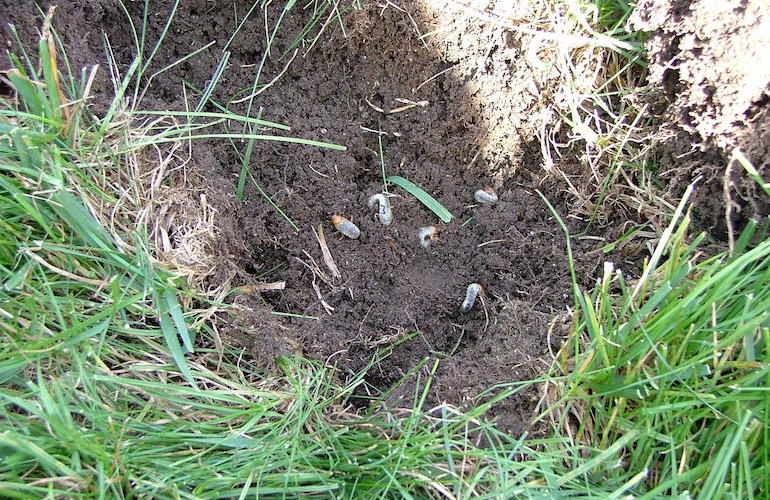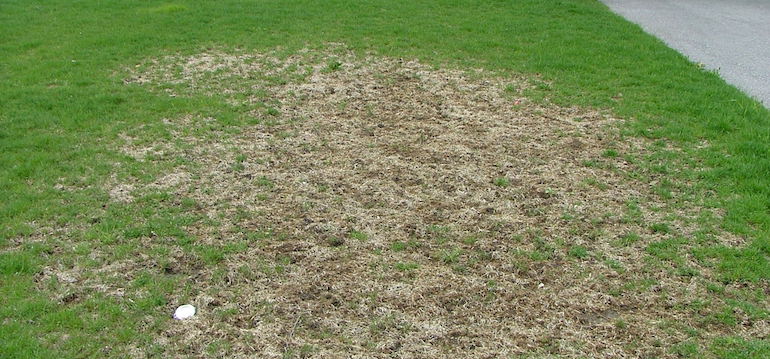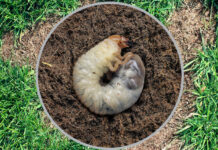
Does your customer’s lawn have a problem with grubs? In the fall, only curative products can be used to control grub populations effectively. The later in the season these products are applied, the farther down the chemical needs to travel in the soil to contact the grubs. In most cases, whether it’s early spring or fall, it’s often preferable to simply wait until the next appropriate window for using a preventative product that gets better results and is more targeted. However, if you still want to pursue fall treatment for better spring outcomes, here are some things to know.
Is it really grubs?
Grubs, which are the larval, or immature, stage of several species of beetles and chafers, damage a lawn by feeding on the grass roots. Healthier grass can tolerate more grub feeding, and all grass can tolerate some grub feeding. A grub infestation, however, will cause patches of thinning turf that gradually increase in size. Grub damaged grass will often pull out very easily at the roots.
Lawn issues that resemble grub damage, though, can be caused by something else, including disease, drought stress, hairy chinch bugs, sod webworms, shade, compaction, and more. The only way to be sure grubs are the problem is to scout for them in the lawn.
- Using a shovel or a lawn edger, make a cut in a 1’ section of lawn where you suspect grub activity.
- Peel up a one square-foot section of grass and soil from that cut. If there is significant grub damage, the grass should peel up quite easily.
- Sift around in the soil, counting the number of grubs found. Ten or more grubs per square foot is a serious infestation. Finding a few grubs is normal and not cause for concern.
Depending on the size of the lawn, you may want to scout for grubs in several places in the lawn. Just because there are a lot of grubs, or not a lot of grubs, in a particular square foot doesn’t mean the entire lawn either does or doesn’t have a grub infestation. You can focus your scouting on areas of the lawn that are showing symptoms of grub feeding. As you’re scouting for grubs in your lawn, take notes so you remember which areas of your lawn have high counts and which don’t. This is important if and when you decide to treat the lawn.
Does it need treatment?
A very high concentration of grubs – 10 or more grubs per square foot – may require treatment to maintain healthy grass. However, if there’s a lower count of grubs, yet aren’t seeing good results in the lawn, that’s a clue that you should revisit lawn care practices more broadly. Some of the best practices we recommend are:
- Testing the soil every two to three years with your state’s Cooperative Extension soil testing service, and following the fertilizer and amendment recommendations.
- Keeping grass mowed high – at least 2”, and ideally 3” or more – so the grass will have a deeper, healthier root system that can tolerate more sub-surface insect feeding.
- Over-seeding bare or sparse areas. Fall is typically the ideal time for this.

White grub damage on a lawn. Photo courtesy of Weed Man.
What about natural treatments?
The two natural products we are asked about most are milky spore and beneficial nematodes. Milky spore is a bacterium that is effective for controlling Japanese beetle larvae, provided the spring soils are sufficiently warm. Research indicates that spring soils in Northern New England are too cold for milky spore to be effective, but anecdotal evidence has shown at least some efficacy in warmer climates. Milky spore may be worth a try if you are sure the grubs are the larvae of Japanese beetles (identifying grub species requires a hand-lens because the differences are very subtle) and can wait several years to achieve good results. One resource for white grub identification is a fact sheet from UMass Extension.
Beneficial nematodes (there are also are non-beneficial nematodes depending on which host they attack) are microscopic worms and can work very well for controlling grubs in residential lawns. Some species of nematodes only control certain species of grubs, so just like with milky spore, identifying the species of grubs is important. Nematodes also need to be applied when the species of grubs they control are active in the soil. To successfully use nematodes for grub control, keep the following principles in mind:
- The lawn needs to be well watered and the soil can’t go dry while the nematodes are getting established.
- The nematodes need to be viable (living) when applied. Purchasing nematodes from a reputable supplier and applying them right away are important.
- Apply the appropriate species of nematode at the appropriate time of year.
- Apply them on an overcast day or in the early morning. Nematodes are sensitive to light and can be killed within a minute if exposed to intense direct sunlight.
- If nematodes are being used curatively, they may need to be applied every two to three weeks until the infestation subsides. For those who use nematodes preventatively, they should be applied two to three times a season.
What pesticides work?
If the client’s lawn has a severe grub infestation and you want to use a pesticide, there are a number of widely available options. As mentioned, this time of year (late summer and fall), only curative products can be used to effectively control grub populations. Ingredients such as carbaryl, trichlorfon, or zeta-cypermethrin are curative and work on contact with grubs. These products can be effective, but are broad-spectrum and have a low residual, so they kill beneficial insects on contact as well as lawn pests like grubs. Their effectiveness is also variable, with wide ranging results. These products should be watered in well, immediately after application.
To help protect pollinators, before applying any insecticides, the lawn should be mowed prior to application so there aren’t weeds flowering in the lawn while the product is being applied. Also be conscious of drift. If it’s windy and you spray an area of the lawn, there’s a chance the product could drift onto flowering plants nearby. Likewise, if you’re using a spreader for a granular product, ensure you limit your application to lawn areas that have a grub infestation. There’s little reason to apply any of these products to an entire lawn if only a section of the lawn has a grub infestation.
From about late April into early June, depending on your geographic region, you can effectively use chlorantraniliprole to control all species of white grubs—it also controls caterpillars such as webworms and armyworms. Chlorantraniliprole works by moving down into the soil and being taken up by grass roots. Grubs are killed when they feed on the treated grass. The process of the chemical being absorbed by grass can take weeks. It’s most effective when young grubs are actively feeding so applying it two to three months in advance of severe grub feeding from June to August is recommended. The U.S. EPA designates this chemical as a low risk pesticide due to its low toxicity to bees and other beneficial insects.
There are several other preventative products in the neonicotinoid class of insecticides. Some examples include imidacloprid, thiamethoxam and chlothianidin. Neonicotinoids are systemic and absorbed by the grass, killing grubs not on contact but rather when they feed on the roots of treated plants. These chemicals and the products they’re in all require slightly different application timing in order to control grubs while they’re active. Generally, these chemicals are best applied from mid-June to early August.
There are also several preventative products that include both a neonicotinoid and a pyrethroid, which provides control not only for grubs but also caterpillars, billbugs, and some other lawn insect pests. Some products registered for controlling grubs just have a pyrethroid, such as products with the active ingredient gamma-cyhalothrin. According to research from Michigan State University, products that only contain lambda-cyhalothrin, gamma-cyhalothrin, bifenthrin, deltamethrin, cyfluthrin or permethrin do not work for grub control.
As a final note, keep in mind that products designed to be used for grubs in the lawn are not designed for use in gardens. Rather, techniques like crop rotation, tilling, and handpicking are better options. Always follow all instructions on the product label, as the label is the law.
 Bernitz is the Infoline Program Coordinator at the University of New Hampshire Extension. An original version of this article appeared here.
Bernitz is the Infoline Program Coordinator at the University of New Hampshire Extension. An original version of this article appeared here.











![[VIDEO] Dickies®: Discover Workwear That’s Anything But Uniform](https://turfmagazine.com/wp-content/uploads/2023/06/1647663814-4b1a2a7742790a9b1e97a3b963477850192e1d6a9dfba9b07214a77bae25d6e3-d-218x150.jpg)





























![[VIDEO] Dickies®: Discover Workwear That’s Anything But Uniform](https://turfmagazine.com/wp-content/uploads/2023/06/1647663814-4b1a2a7742790a9b1e97a3b963477850192e1d6a9dfba9b07214a77bae25d6e3-d-324x160.jpg)
Thanks Nate for a great post! I like what you said, “To help protect pollinators, before applying any insecticides, the lawn should be mowed prior to application so there aren’t weeds flowering in the lawn while the product is being applied. Also be conscious of drift. If it’s windy and you spray an area of the lawn, there’s a chance the product could drift onto flowering plants nearby.” Interesting fact is that grubs are like “an appetizer” for moles, prior to eating earthworms and the main course.